VK9AR OC-216: Ashmore Reef – Australia’s last frontier
Mike AB5EB, Mike AD5A and Craig VK5CE
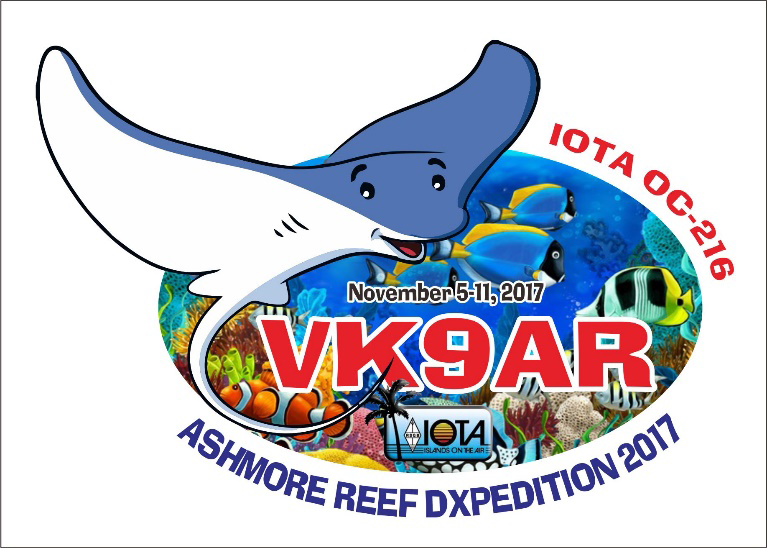
The VK9AR OC-216 DXpedition was an amazing and exciting adventure to one of the most remote parts of Australia. The Ashmore Reef Commonwealth Marine Reserve is located on Australia’s North-West Shelf in the Indian Ocean at 122°59’E, 12°11’S, about 330 nautical miles (610 km) north of Broome (VK6) and just 80 nautical miles (145 km) south of the Indonesian Island of Pulau Rote (YB9). IOTA OC-216 is made up of uninhabited, small, low lying islands composed of coral and sand, with some grass cover.
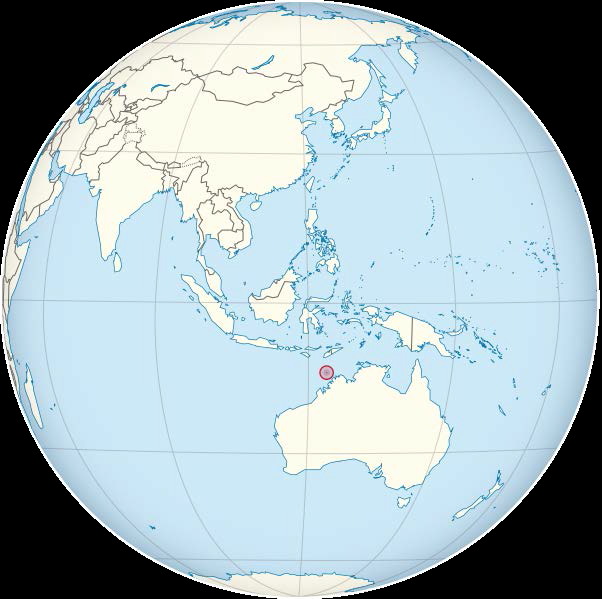
Indonesian fisherman have traditionally utilised the coastal resources of Ashmore Reef since the early eighteenth century. Prevailing trade winds and local land marks were used to set course and sail between the islands. The first recorded European discovery of the islands was in 1811 and the 1850s saw the operation of American whalers in the region later followed by phosphate mining.
Due to its proximity to Indonesia, and the area being traditional fishing grounds of Indonesian fishermen for centuries, some Indonesian groups claim Ashmore Reef to be part of the East Nusa Tenggara province. In 1974 Australia and Indonesia entered into a Memorandum of Understanding recognising the traditional use by Indonesian fisherman of the territory’s resources, and granting the rights of access to Australian waters. Under the Memorandum of Understanding traditional Indonesian fisherman are permitted to land on West Island to replenish their stores of fresh water, visit the graves of past fishers and to take shelter in the West Island Lagoon. Defence of Ashmore Reef is the responsibility of Australia by the Royal Australian Navy and Australian Customs and Border Protection Service. When illegal activity is suspected crews are arrested, prosecuted and their vessels impounded.
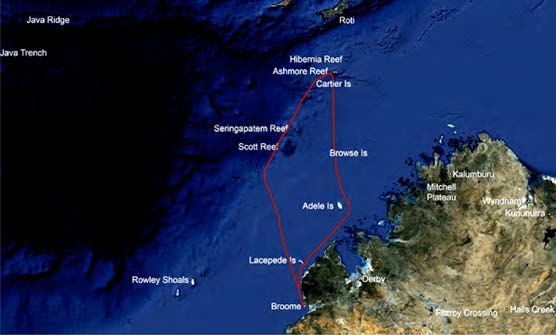
Ashmore Reef is of the most remote parts of the country, Australian vessels very rarely visit it as its three days away from the nearest port of Broome. The reef boasts high species and habitat diversity with 14 varieties of sea snake, 433 species of mollusc, 70 fish species and 255 varieties of coral. The islands also have significant marine turtle nesting areas, migratory bird populations, stingray, dugong and whale sharks. Whilst at Ashmore Reef, the Bird Watchers and Researchers focussed on migratory shorebirds and seabirds, in particular bridled terns, common noddies, brown boobies, eastern reef egrets, frigatebirds, tropic birds,
red-footed boobies, roseate terns, crested terns and lesser crested terns.
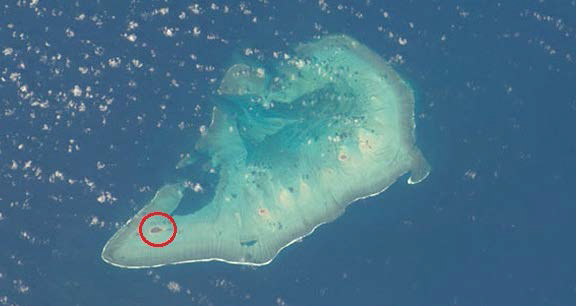
Apart from those IOTA’s that have never ever been activated before, OC-216 is now the 5th rarest on the IOTA Most Wanted list being claimed by only 1.9% of chasers. Way back 21 years ago in August 1996 Steve AA6LF went to OC-216 for its one and only activation as VK4ALF/VK9 making 467 QSOs. We also operated from the uninhabited low lying West Island made up of coral and sand with some grass cover. It’s a small island measuring 680m (2200ft) west to east at its widest part and 450m (1480ft) north to south at its longest point.
Mike AB5EB and Mike AD5A flew out on Wednesday November 1 from San Antonio to reach Sydney in VK2 by early Friday morning. Meanwhile on Thursday Craig VK5CE was in final contact with the Senior Border Force Officer in Broome from Australia’s Border Force to make sure they knew we’d be on Ashmore Reef. Back in the air, Mike and Mike started their long 4.5 hour flight from Sydney to Perth in VK6 whilst Craig flew from Adelaide VK5 to Perth. It was great to reunite in Perth and then fly north to Broome for 3 hours to arrive there at 7pm local time. Both Mike’s travelled for 34 hours via plane from San Antonio to Broome!
On Saturday with the heat of 35C and 80% humidity, Broome is certainly a tropical paradise but it’s also a hot and sweaty place during the “build up” – this is the transition between the tourist friendly dry season and the wet season. It was good for us because a lot of the tourists had left Broome for the season and the town wasn’t too busy, but the weather made life uncomfortable. We had brought all our radio gear with us on the plane and Craig had freighted the generators and band pass filters to Broome prior to our trip. Now it was time to get life support equipment to build a radio city.
We loaded up the hired four-wheel drive with all the antennas, coax and pelican boxes and had enough space in the vehicle for some more gear, so it was time to visit Broome Hire Centre for equipment we pre-hired. Our boat Captain was very accommodating and after a quick phone call he met us down at the Town Beach boat ramp so that we could give him the gear for loading onto the boat. This was a chance for us to talk a about the detailed logistics of the DXpedition and he was happy with how things were progressing. We then headed off to camping and hardware stores to purchase equipment that was too expensive to ship up or hire and was cheaper to just buy and leave with the Captain as a thankyou gift. This included fuel containers, fuel, shade structures, guy poles, extensions cords, fans, first aid items and all the other items needed to build an effective station to operate and survive in the oppressive heat and humidity of a baron uninhabited tropical island. We filled the 4WD vehicle for the second time and offloaded the equipment to the Captain again.
So, with that critical job done, we could breathe easy knowing that all radio equipment was on board the vessel. After lunch we could spend the afternoon talking DXpedition strategy and doing more shopping for personal items.
At 0000 UTC on Sunday November 5 we boarded and left Broome, seas were a bit rough and after 4 hours at sea Craig and other bird researchers became seasick and spent the rest of the day and night in bed as the seas became extremely rough.
On Monday the seas were better, so we were all to spend the day out of bed and eat food again. The three of us continued to talk strategy including the format of the new IREF website which will be done in the new year. The birdwatching researchers have similarities to DXers. As soon as a rare species is spotted on the boat, others with big binoculars and cameras come running – sound familiar? Mike AB5EB tried his hand at fishing and managed to land his first Indian Ocean fish and then Mike AD5A was able to make the same claim a few minutes later. There were some great sites on the water with pods of short finned pilot whales, dolphins including bottle nose, Fraser and the rarer spinners to keep us entertained.
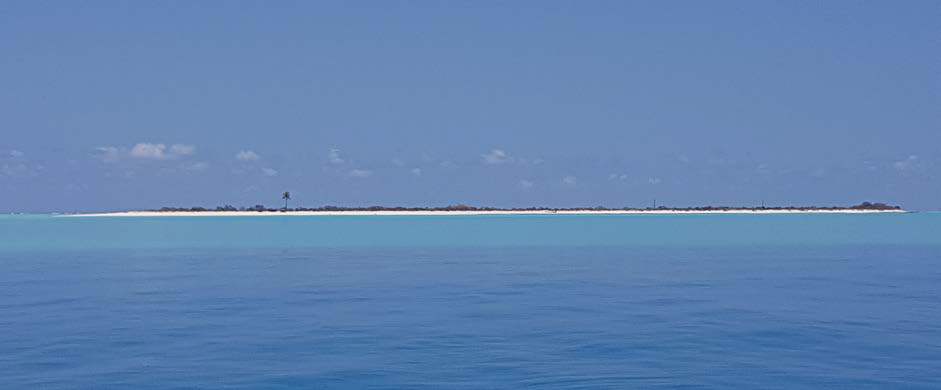
On Tuesday it was our third day at sea and the boat arrived at the Ashmore Reef Marine Park at 3pm local time which was a few hours later than expected. The Captain made contact over the radio with the Australian Border Force vessel permanently stationed at Ashmore Reef to intercept illegal boat people entering Australian waters. After a short while we were boarded by Australian Border Force personnel to inspect the boat and assess the permits and documentation of our operation, the bird researchers and the vessel itself. I’d already spoken to and then emailed the details and documentation of our operation to the Senior Border Force Officer at the Western Australian Regional Command just prior to flying to Broome. So the Border Force Officers already knew about our radio operation and this made the whole process so much easier. The main issue was to ensure that we had appropriate life support on the island and that we would be able to safely arrive and leave the island based on the tides there.
The hours that we operated on Ashmore Reef were dictated by the tides. It was now 4pm, two hours before darkness and the Border Force Officers gave us approval to land on Ashmore Reef and build our camp and erect antennas, but it meant that by the time we were finished it was dark and so they would not allow us to safely return to the boat. This scenario was ideal as it meant we could operate overnight at times that were favourable to Europe and North America. This was the case for the first three evenings where tides and safety considerations meant that we could be on the air for longer than originally expected. The downside was that we could not operate for a fourth day because the boat needed to depart at 9am local time and the tides would have left us stranded on the reef.
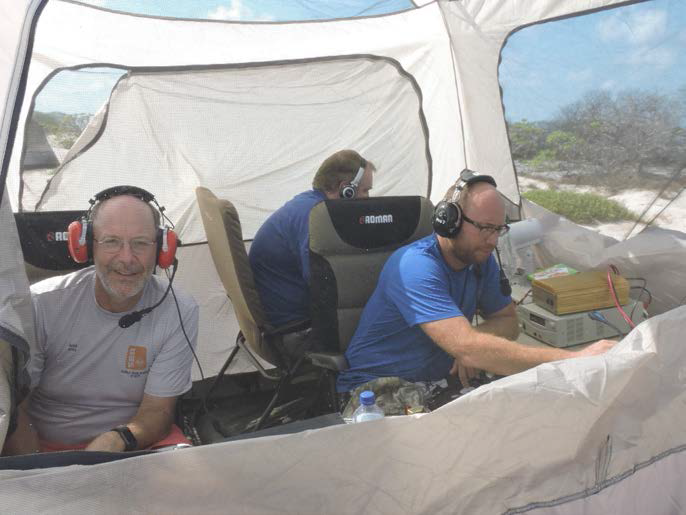
Mike AD5A, Craig VK5CE, Mike AB5EB
So on day 1 of operation at 4pm local or 0800 UTC we left the boat in an overloaded aluminium outboard to try and beat the lowering tide. The weather was around 35C and 80% humidity and it was incredibly hard work to quickly erect a station with 3 operating positions before the sun went down. By 1000 UTC we were on the air with 20m SSB 400W, 30m CW 300W and 40m 100W. Pile ups were of course horrendous and Craig and Mike (AD5A) called it quits 8 hours later at 1800 UTC after 20m and 30m closed whilst poor Mike AB5EB kept going on 40m until sunrise. We had the three stations up and running again the next morning at 2130 UTC until 15m/20m/30m dried up around 0000 UTC. There was sleep deprivation, heat stress and fatigue but it was counterbalanced with the excitement and adrenalin of successfully getting the island on the air to all parts of the word.
We limited the different band and mode slots put on air to limit dupes and maximise uniques. It also had the advantage that each operator would understand the propagation of their band better and would know when to listen to hard to reach places. The pattern would be generally around 0800 UTC in the afternoon we would start as Mike AB5EB on 15m CW (barefoot), Mike AD5A on 17m CW (300W) and Craig on 20m SSB (400W). Then as the evening continued Mike AB5EB would go to 40m CW (barefoot) and Mike AD5A transitioned to 30m CW (300W) and we all continued until the bands individually closed.
Overnight the temperatures were around 25-28C and the humidity was still very high, and we were lucky to sometimes have a light breeze to fan our sweaty sand encrusted bodies. We would squeeze in a couple of hours sleep before rising at sunrise and by around 2100 UTC we’d have Mike AB5EB starting on 20m CW (barefoot), Mike AD5A 30m CW (300W) and Craig VK5CE 40m SSB (400W), then AD5A would transition over to 17m CW and Craig would go to 15m SSB and all three stations would continue to around 0100 UTC when the bands would die. Then around 0800 UTC in the afternoon the routine would continue.
We would frequently ask for North America only or Europe only to maximise QSO’s to the longer haul destinations and on 20m Craig would also call for United Kingdom and Scandinavia only. This worked well with many W1s and VE3s getting in the log and over 100 EI/UK stations and over 200 Scandinavians.
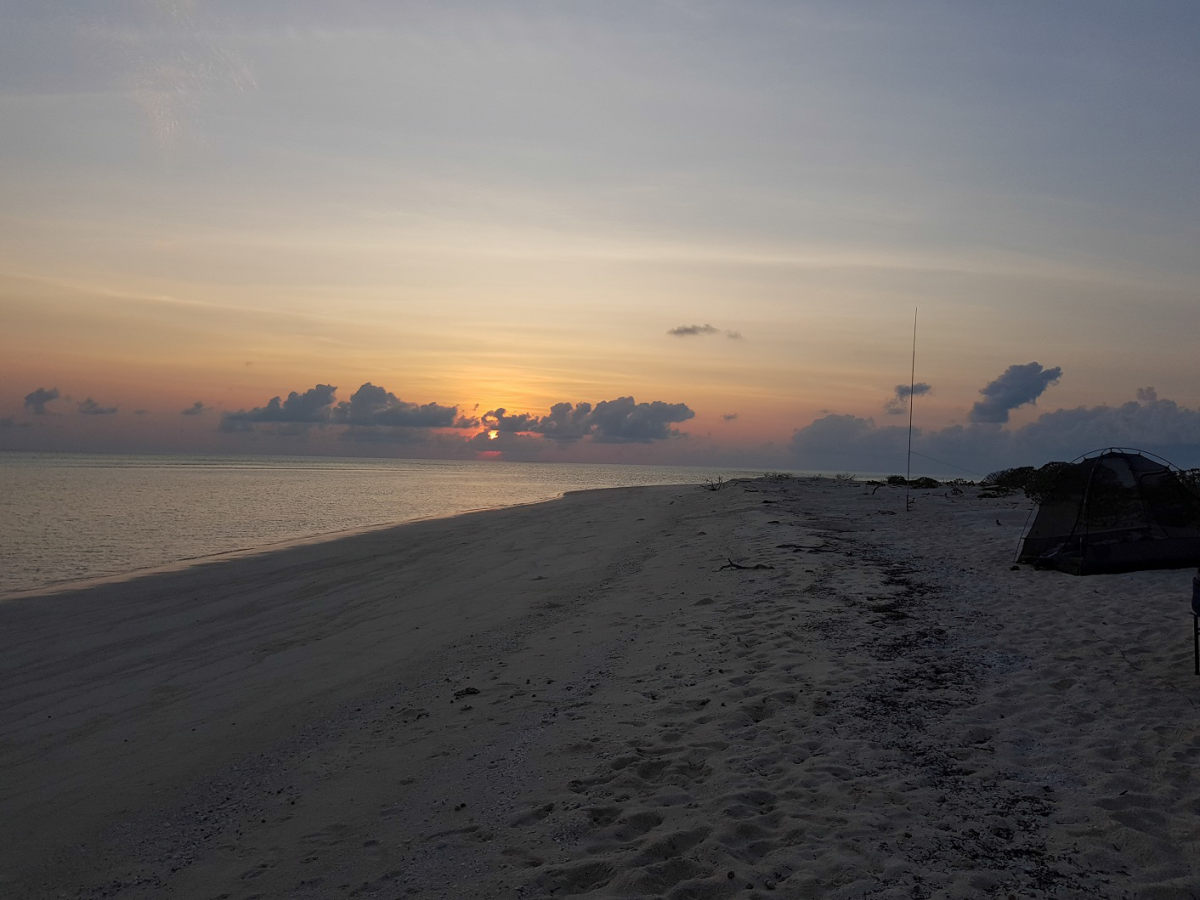
Sunrise, Ashmore Reef.
Lots of challenges presented themselves, for example in the extreme conditions, a power supply failed but we managed to rig two K3s to run off one power supply to power the 75W CW station and squeeze enough power into the amp from the second K3 to get 300W out. The second biggest challenge was the sun, with the SFI in the 70’s, A index in the 30s and the K index hovering between 4 and 6 we felt that despite horrible band conditions we were successful in averaging over 1000 QSOs per person per day. The biggest challenge was the weather, it was hot and humid, I mean really hot and humid……… no I mean REALLY hot and humid. When packing up the VK9AR radio city we were pushed to our physical limits and the thought of finally being able to rest on the oasis of the boat was enough to keep us going.

Verticals at low tide
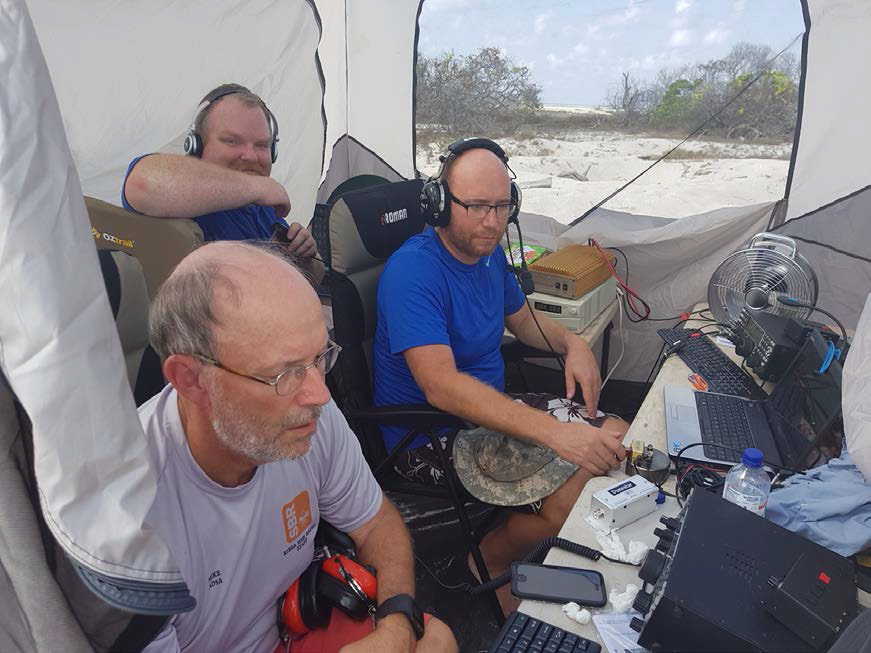
Mike AD5A after 30m closed, Craig VK5CE after 40m closed, Mike AB5EB on 20m
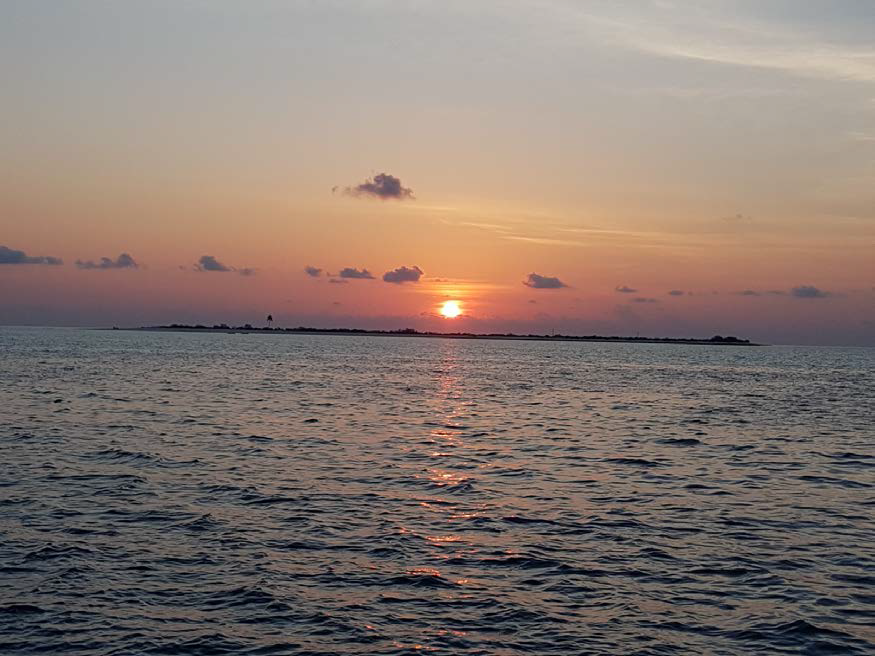
Sunset on Ashmore Reef, departing for Browse Island next morning
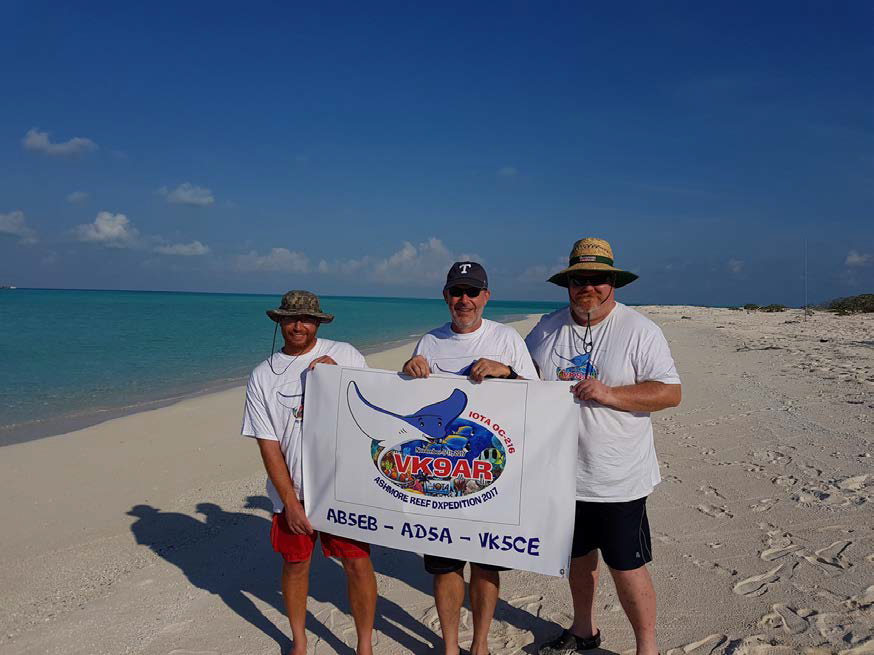
Mike AB5EB, Mike AD5A, Craig VK5CE on Ashmore Reef
On the return journey from Ashmore Reef to Broome, there was an opportunity for the bird researchers to do a quick 2-4 hour visit to Browse Island to do some bird watching. Browse Island OC-234 is a small 35 acre uninhabited island which is an important nesting site for Green Turtles and many seabirds. This presented us with the chance to do a quick activation there as well. We had no choice of the arrival/departure time or length of stay, this was purely for the birdwatchers. But considering this IOTA was activated once only in 2000 and was only claimed by 10.2% of chasers, we made the effort to get it on the air with 2 stations for as long as we could. The boat arrived at the island in the dead of night and we were on the back of the deck ready to go at 330am (1930 UTC). As Browse is surrounded with a rocky coral reef and there was a nasty swell at the reef, we could not land there during the dark. The earliest the captain could safely let us depart was 445am (2045 UTC). We landed on the steep beach and quickly brought up the tent, generator, antennas, rigs, amplifiers etc and 45 minutes later we were on the air with one station on 20m CW (300W) and the other on 17m SSB and CW running barefoot. Due to the safety issues of landing, it was unfortunately too late in the morning for Europe and only some got in the log. To our great surprise conditions on both 20m and 17m were good across the entire continent of North America (even with 100W SSB on 17m). We know that Europe missed out with this, but remember that OC-234 wasn’t a DXpedition, it was just a quick visit on the way back from the OC-216 DXpedition where we operated as an additional bonus to hundreds of IOTA chasers who were lucky enough to work us.

About to start the second station on Browse Island at sunrise
The weather on Browse Island was again oppressive. But as we loaded the last bit of gear back on the boat, we looked at each other and we amazed, did we really just spend 4 hours on that island, it was over in a blink of an eye. On Sunday and Monday, the return boat journey from Browse Island to Broome was incredibly rough. Everyone spent most of their time in bed due to safety reasons, glasses and crockery on the boat smashed in cupboards and downlights would fall out of the ceiling from the smashing of the boat on the waves. We all agreed that it was easy to sleep in our bunks when we were floating in the air above our beds, but we would tend to wake up when we got body slammed onto the bunk!
On Tuesday November 14, everyone was delighted to arrive safe and sound in Broome and the following day we spent time returning hire gear, picking up the remaining equipment from the boat and freighting back gear to Adelaide in VK5 such as generators. The team would like to thank our sponsors and we hope to have the chance to bring you another rare one again in the future.
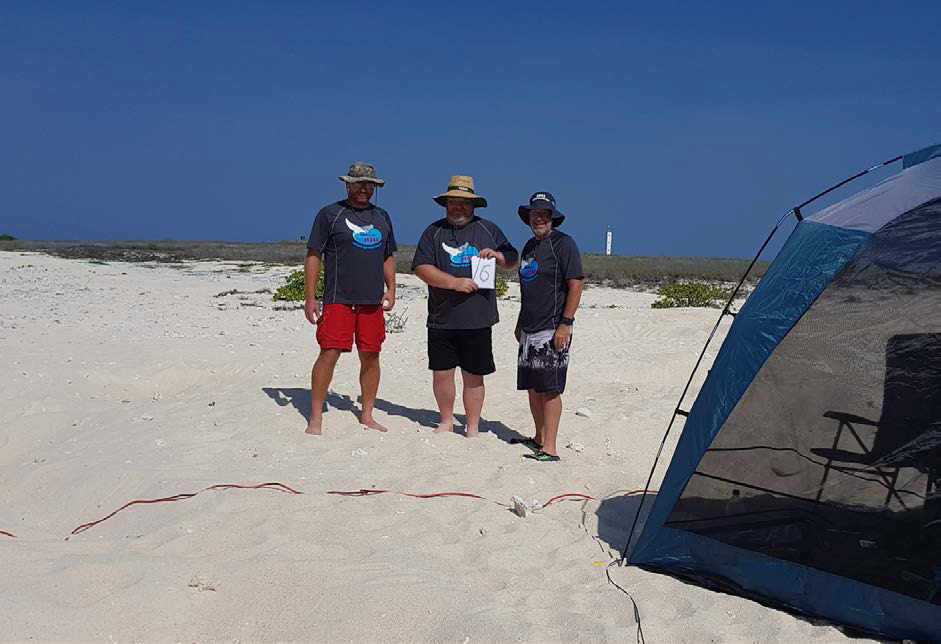
Mike AB5EB, Craig VK5CE and Mike AD5A on Browse Island OC-234
Final results were:
AB5EB Mike, AD5A Mike and VK5CE Craig operated as VK9AR (OC-216) for 2.5 days (2 days 13.5 hours) and made 8167 QSOs. AB5EB and AD5A operated CW and VK5CE was on SSB. QSOs were Asia (50%), Europe (33%) and North America (13%) with 62% CW and 38% SSB.
We also operated as VK9AR/6 (OC-234) for 3 hours and made 725 QSOs with Asia (72%) and North/South America (21%) again with 62% CW and 38% SSB.

